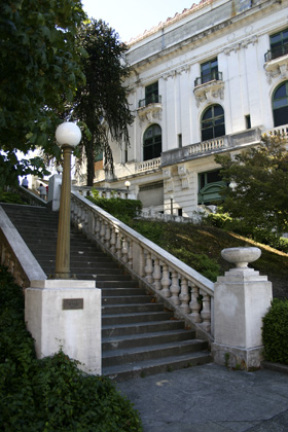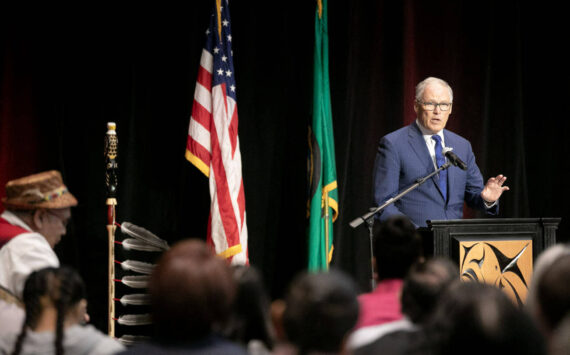It is arguably the most neglected pedestrian walkway downtown.
Sure, the zig-zagged hill climb connecting Pacific Avenue to Broadway — an area where overgrown shrubs, sharp corners, and scores of blind spots leave pedestrians on the defense — needs attention. And the rusted, vertigo-inducing staircase beneath Murray Morgan Bridge, connecting downtown to Foss Waterway, is another decayed passageway.
But nothing compares to the Spanish Steps.
Located near South Seventh Street and Broadway, it connects Commerce Street to Broadway, near Old City Hall, and is a crumbled collection of concrete colonnades, once-decorative urns, and chipped steps.
Recently, vandals toppled and smashed two decorative urns. A couple years ago, a driver lost control of his vehicle and drove down the steps, knocking out a grill of colonnades that front a landing with views of Tacoma’s tide flats. And police officers have long complained the steps serve as an entry point for homeless people seeking shelter inside the adjacent and abandoned former Elk’s Lodge. A visit to the area this week revealed smashed 40-ounce beer cans, broken glass, and a plump rat that scurried between bushes.
But a plan to repair the steps and return order to the area continues to gain momentum.
In May, the City received a Transportations Enhancement grant totalling $944,000 from the Washington State Department of Transportation for design and repair work. Additional federal funding brings the total purse to $1.2 million.
On Wednesday, the City of Tacoma’s Landmarks Preservation Commission approved recommendations from a local design firm on ways to use those funds to rehabilitate the landmark.
The key word: rehabilitate.
According to Michael Sullivan, a principal at Artifacts, Inc., a local consulting firm that contracted with the City in 2004 to study the project and provide recommendations, original designers used pulverized marble and cast stone to create a concrete-like material to comprise the staircase. Though cost-effective nearly 100 years ago, today the process is obsolete.
“It’s like Cartier jewelry made out of aluminum instead of platinum,” said Sullivan, who presented recommendations during this week’s meeting. While compiling the report, Sullivan’s firm tracked down two contractors capable of replicating this process. The closest — located in Texas — even discouraged this idea for restoring Spanish Steps. “We really looked hard at reproducing cast stone. It’s not realistic to think about full restoration.”
A 36-page report presented Wednesday includes recommendations to repair existing concrete, masonry, metal, and cast stone elements, as well as recommendations for thermal and moisture protection. It also includes a list of recommended suppliers for the replacement materials, contractor qualifications, and an itemized task list.
According to City of Tacoma historic preservation officer Reuben McKnight, Artifacts’s recommendations for treatment and repair are designed to guide the City in putting together bid documents and specifications. The recommendations are based on the Secretary of the Interior’s standards for the treatment of historic properties, as well as the National Park Service’s preservation briefs, which are the same standards adopted by the City’s Landmarks Preservation Commission.
The City is expected to solicit bid requests in early-August, and award a contract in mid-October, according to the City’s construction projects list. Once awarded, rehabilitation would take approximately three months, and could be completed in early-2008.
The Spanish Steps were built in 1916, and modeled after its famed namesake in Rome. They are located within the Old City Hall Historic District — an area listed on local, state, and national historic registers. In the 1950s, the steps started to degrade. Shoddy patchwork, deferred maintenance, and vandalism contributed to its continued decline.
Sullivan estimated that proper rehabilitation would give the Spanish Steps another 25 years of life. Perhaps more important, restoring it as an attractive setting serving a vital hill climb passage would give downtown visitors a reason to visit the area.
“It’s amazing,” said Sullivan. “At one time, these steps were used heavily.” He noted the steps were used to connect a streetcar line on Broadway to Old City Hall on Commerce Street. “[Today], they don’t seem safe to anybody. When they are not used heavily, they become a target [for vandalism].”








